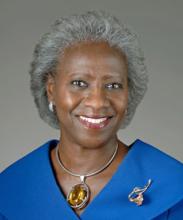
August, 2020
DR. VALANTINE'S FOOD FOR THOUGHT

Hannah A. Valantine, MD
Chief Officer for Scientific Workforce Diversity
Many of us are dealing with the impact of two colliding pandemics: COVID-19 and structural racism. The events of the past two months, highlighting the disproportionate deaths of African Americans from police brutality and COVID-19, has had reverberating effects on individuals and institutions within science and medicine. Despite these devastating experiences, this moment created fertile ground for significant change. In this issue, we cover several topics related to the outpouring from underrepresented scientists, doctors, and other professionals in health care who are offering calls for progress and solutions.
Despite these unprecedented times, I will leave you with a few words of encouragement from the great Dr. Martin Luther King Jr.
“We must accept finite disappointment, but never lose infinite hope.”
Calls for Science and Medicine to 'Look in the Mirror'
In recent weeks, powerful op-eds from eminent scientists and physicians were published, discussing personal or systemic instances of racism and called for changes within academia and medicine. One thought-provoking article, by Dr. Robert Sellers, expresses the sense of exhaustion many of us feel in this space of facing social injustices within the scientific community. Another compelling op-ed, from the Editor-in-Chief of Science, Dr. Herbert Holden Thorp, called for us to recognize the scientific enterprise is not immune to racism and asked: "If there had been more diversity in science and medicine, would we have the painful legacy of the Tuskegee Syphilis study, the lack of recognition of Henrietta Lack's contribution to science?" To this compelling statement, I would also raise the question "would we have seen the COVID-19 disparities related to infections and deaths in African American, Hispanic, and and American Indian communities?" Lastly, a reflection in a Forbes article quoted Dr. Fatima Cody, a Stanford physician-scientist, who discussed the issue of having to manage contrasting feelings related to the daily deluge of news on the black community's plight, while needing to act 'as normal' in her academic positions. Speaking in general terms, she says: "We are worn. We are tired. We are mustering up 'just enough' energy to make it through." These pieces are all strong and overdue calls that reflect the pervasive issue of structural racism in science and medicine.
#SHUTDOWNSTEM and #BLACKINTHEIVORY
The message is clear that the time for change is now. Several high-profile events, including those on social media, highlighted structural racism as a deeply embedded issue within science and medicine. The twitter hashtag #BlackInTheIvory placed a spotlight on the plight of being black and underrepresented in science with several black professors and trainees offering glimpses into what it means to be black in science. As an example noted in one article, Dr. Dorothy A. Brown expressed dismay because she was reprimanded by her Dean for advocating that the hiring committee she was on interview a highly qualified black applicant.
Another twitter born-event that received considerable attention was #ShutDownSTEM. The hashtag evolved into an initiative for university laboratories, scientific societies, and others to spend an entire day (June 10th) focused on enhancing racial equality and inclusiveness at their institutions. This called for no classes, research, or research-focused meetings, but instead asked for engagement in trainings and other activities dedicated to addressing disparities. Many institutions participated, and the conversations are a promising sign of the meaningful changes to come within the culture of scientific research.
Federal Agencies Receive the Call
Recent cries for change have not only reverberated through academic institutions and medicine, but they have also sparked calls for 'changing the system' at some federal agencies. The commonalities in the groundswell of voices calling for institutional change, include more representation at the leadership level and direct statements by agencies about the impact of racism. Many institutions, including our own, are having difficult, yet important, conversations internally, providing safe spaces, and hiring consultants to adequately address the tidal wave of interest surrounding anti-black racism discussions and actions. These unprecedented calls further underscore the influence of our current events on many different aspects of our scientific community.
Where Do We Go From Here?
he widespread effects of recent events, an important question is "where do we go from here?" While it is difficult to address all of the nation's issues, my colleagues Drs. Kenny Gibbs, Alison Gammie, and Jon Lorsch at NIGMS focused on the scientific workforce in a blog post, addressing anti-black racism in the biomedical research enterprise. They discuss how NIGMS is tackling the issue and offer advice to majority groups at research institutions: recognize/reduce systemic and explicit bias, emphasize cultural assets rather than deficits, support the need for a higher purpose (e.g., giving back to the community), and reassess evaluation metrics for (trainee and faculty) advancement to avoid perpetuating systemic bias. This last piece is particularly important, as a recent study suggests individuals on faculty search committees rely on idiosyncratic preferences to assess research, teaching, and service credentials—which can hamper diversity. Another colleague of mine, Dr. Michelle Jones-London, echoes similar advice in a recent Cell publication and further argues for institutional approaches to enhance researcher diversity by: eliminating barriers for career transition, providing resources to develop meaningful mentorship, connecting individuals to supportive scientific and professional development networks, and developing policies/resources to enhance diversity in neuroscience. In line with this, our office has established the Faculty Institutional Recruitment for Sustainable Transformation(FIRST) program which aims to create cultures of inclusive excellence at NIH-funded institutions, by establishing a faculty cohort model for hiring, multi-level mentoring, and professional development. In combination with other developing efforts, we hope this leads to sustained changes that will further inspire diversity at our nation's scientific institutions.

The links above are pulled from the top news articles trending on the subject of diversity in science and technology.
The stories selected are not a reflection of the views of the National Institutes of Health.

